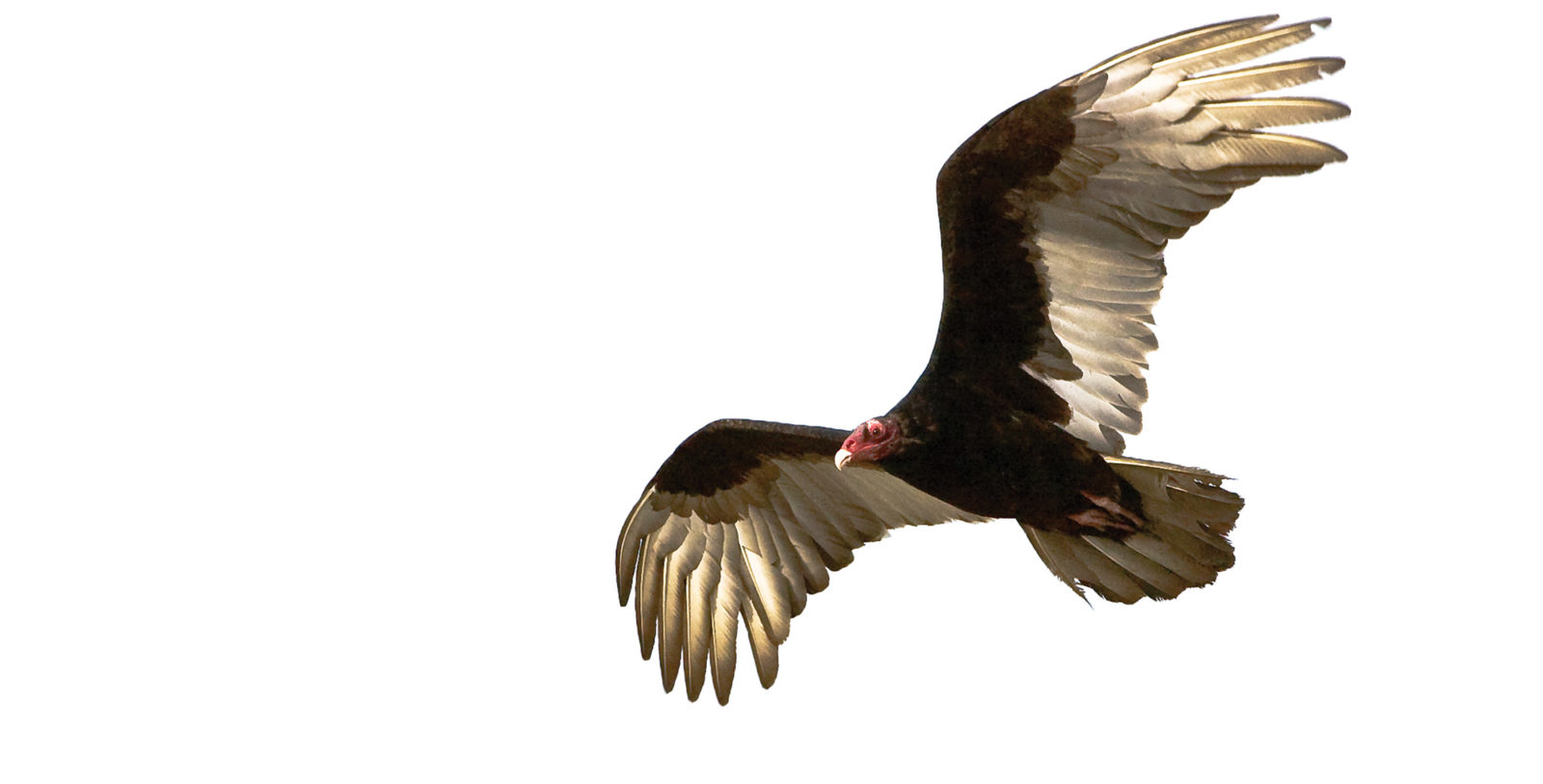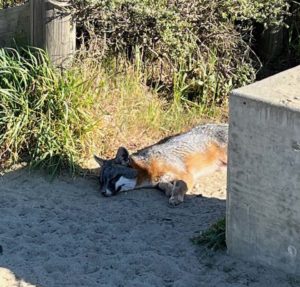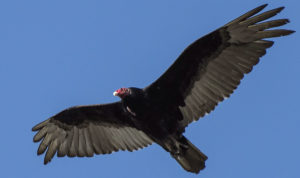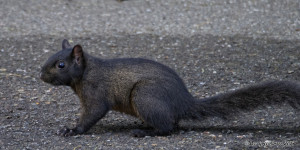When you’re eyeball to eyeball with a turkey vulture, you wonder how he perceives you. (My “he” is Vladimir, a 30-year-old male, permanent resident of WildCare in San Rafael.) You may think of William Leon Dawson, an early celebrant of California birds: “…when the buzzard sweeps low to bend upon you an inquiring eye, you shudder…[I]t is really the grave which appraises you in that deferential, hopeful gaze.” Or the poet Robinson Jeffers on a bare hillside near Big Sur, “under inspection,” telling the bird: “These old bones will still work; they are not for you.” You might even remember, as Jeffers apparently did, the ancient custom of exposing the dead to be consumed by vultures, still practiced in parts of Asia: “What a sublime end of one’s body, what an enskyment; what a life after death,” he wrote.
Vlad, who is being hand-fed mealworms by wildlife rehabber Alex Godbe, probably doesn’t see me as unripe carrion. He’s imprinted on humans, though most of us make him nervous. Godbe, a raptor whisperer if there is such a thing, got Vlad used to leaving his cage, being handled, and traveling to schools and such in a dog carrier. He’ll tolerate WildCare volunteer Maggie Rufo. But he flinches if anyone else gets close, and a whitening patch on his head’s red skin signals anxiety.
That skin, not quite bare, is flecked with short hairlike black feathers. Loss of head plumage is an adaptation for feeding on messy carcasses that New World vultures and condors share with the superficially similar but not closely related Old World vultures and a few stork species. Conventional plumage would become matted with gore.
A blood test a few years ago determined Vlad’s gender—the only way to tell the sexes apart. That’s not the only thing that’s difficult to determine with vultures. They might be common, but where they nest and where they go remain mysteries. Vlad, for instance, was found in Marin, but it’s not known for sure where he was born. If he was born in Marin, he and a single sibling probably hatched in a cave or a rock pile. It’s hard to be more precise; breeding-bird atlas compilers report that turkey vulture nests are hard to locate. Farther north, turkey vultures nest in the burned-out redwood stumps that loggers call goose pens. UC Cooperative Extension biologist Greg Giusti says that in the Mendocino woods near Hopland, where he is studying the big birds, they use hollowed-out valley and Oregon white oaks: “They’re essentially tree caves, some only two feet wide with entrances 10 to 12 feet up the trunk. The vultures can’t fly in and out; they shinny down to the ground-level nest using feet and elbows.” That’s also how they exit, like chimneying rock climbers.

His handlers call Vladimir curious and social—adaptive traits for a scavenger reliant on shared meals. Outside the nesting season, vultures congregate in roosts that function as information centers: Vultures that failed to find a carcass the day before might follow their luckier neighbors when they return for second helpings. Turkey vultures rarely make their own kills, and their few documented victims (grouse chicks, minnows) are small and defenseless. They scour the landscape for the dead, alert to whiffs of decay. In the 1950s, amateur ornithologist Betsy Bang showed that the smell-processing part of a turkey vulture’s brain is proportionately larger than in birds of comparable size such as the turkey. Experiments dating back to Audubon’s day established that turkey vultures, unlike even other vultures, can locate concealed food: A Connecticut turkey vulture exhumed a dead woodchuck that had been buried half a foot deep. They can be picky, rejecting food that’s too far gone, and will dissect and discard a skunk’s scent gland before consuming the skunk. Resistant to most pathogens (including botulism, salmonella, and anthrax), they are nonetheless susceptible to commercial rodenticides.
Turkey vultures are built for low-altitude, steadily patrolling flight. With six-foot-long, narrow wings tilted above the horizontal to form a shallow V, vultures rock in the air currents—one of their best field marks. As Pete Dunne and Clay Sutton say in Hawks in Flight, they “teeter unsteadily even in windless conditions, wobble when it’s breezy, and reel drunkenly in strong winds.” Teetering, counterintuitively, helps stabilize flight while allowing the vulture to cruise low enough to pick up scents. Flying vultures expend minimal energy. “When we had heart-rate monitors on turkey vultures, we found that flight costs them next to nil above perching,” recalls Keith Bildstein, conservation director of Pennsylvania’s famous Hawk Mountain Sanctuary.
For long-distance flights, they catch thermals—elevators of heated air—and ride them as high as four miles. “Turkey vultures are more flight-efficient in thermals than other soaring raptors,” says Allen Fish, director of the Golden Gate Raptor Observatory. Red-tailed hawks and other species keep an eye on them, following them up.
In the fall, thousands of Vlad’s relatives move south. Over the species’ huge range, from Saskatchewan to Tierra del Fuego, some—not all-—populations migrate seasonally. We know surprisingly little of the details; they’re less intensively studied than rarer species like California condors or peregrine falcons. Only 50 or so have been equipped with transmitters that allow satellite tracking. Traditional leg bands can’t be used on New World vultures: like storks, they defecate on their legs and feet, rendering band codes unreadable. Wing tags are more feasible, but not widely used.
Fish, watching the fall passage of raptors through the Marin Headlands since 1989, has seen turkey vulture numbers increase from about 2,000 to a peak of 11,000 in 2003, leveling off to a current 7,000 to 8,000. “From mid-August to mid-December, there are always turkey vultures in the sky,” he says. Late September is the high point. They travel in small groups, sometimes up to 25. Some must be southbound, others are locals just hanging around a nearby Caltrans roadkill disposal site: “It’s hard to judge,” he says.
A much larger contingent, 33,000 strong in some years, moves down the west side of the Sierra Nevada into the Kern River Valley, where they’re honored with an annual September festival. Fish believes the interior and coastal streams are separate: No one has observed migrants crossing the Central Valley. Maybe they merge farther south, in Mexico, joining the immense flocks that funnel through Veracruz, Costa Rica, and Panama. No one knows. Also unknown: whether adults and juveniles travel together.
Bildstein tells of five vultures that were equipped with radio transmitters in Southern California in 2005 and 2006. One never left California; the others traveled as far north as Washington State, as far south as Central America. One made a detour down the Baja California peninsula, then crossed the border back into California, made a U-turn, and proceeded south across mainland Mexico to Guatemala. Two others wintered in western Mexico. Vultures that nested in southern Canada went farther, all the way to Venezuela.
Meanwhile, winter visitors from the north move into the Bay Area. Bildstein suspects they’re coming from British Columbia, although none have been tracked yet. Audubon Christmas Bird Count data show dramatic increases in the winter population locally since the 1960s and ’70s, from single digits to 1,001 on the 2006 Point Reyes count. Eight other local counts recorded record highs within the last six years. Climate change? More food available? It’s anyone’s guess. Whatever draws them, they’re the region’s most abundant wintering bird of prey (running second to red-tailed hawks in the nesting season and fall migration).
The Golden Gate also hosts a northbound raptor migration in spring, serendipitously discovered nine years ago by a falcon watcher. “Numbers are lower than in fall, but turkey vultures are the stars,” Fish says. In the low thousands, they can outnumber red-tailed hawks, the next most common species, by three to one.
It’s odd that we know so little about such a common, conspicuous, and ecologically indispensable bird. Giusti’s project is only the third study of nesting turkey vultures in California. The more biologists learn about them, the more impressive vultures’ behavioral flexibility appears. Along with now-rare condors and extinct teratorns, these consummate survivors jostled for scraps of mammoth and ground sloth at the site of today’s La Brea Tar Pits—and they’re still prospering, with five million or more of them in the world. International Vulture Awareness Day is the first Saturday in September; mark your calendar for next year. Or, the next time you’re in San Rafael, pay Vladimir a visit.





